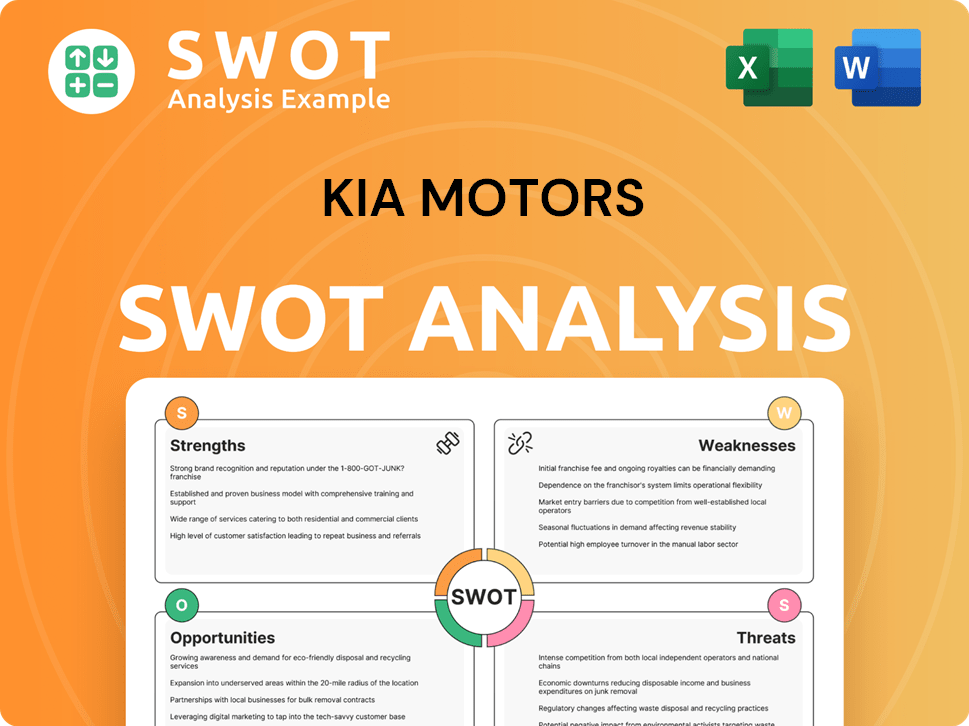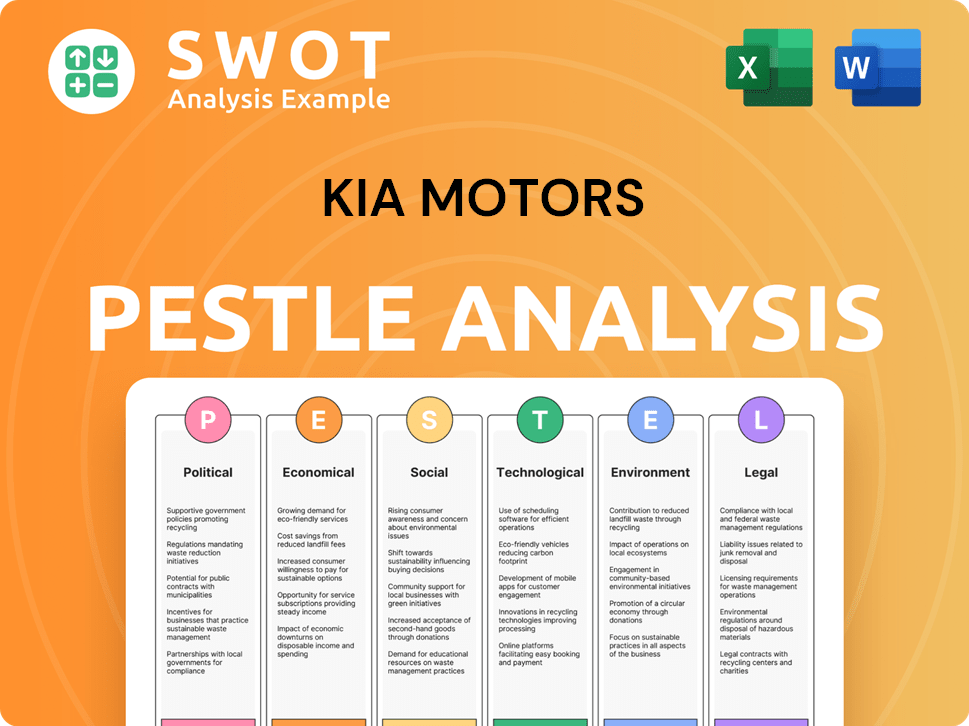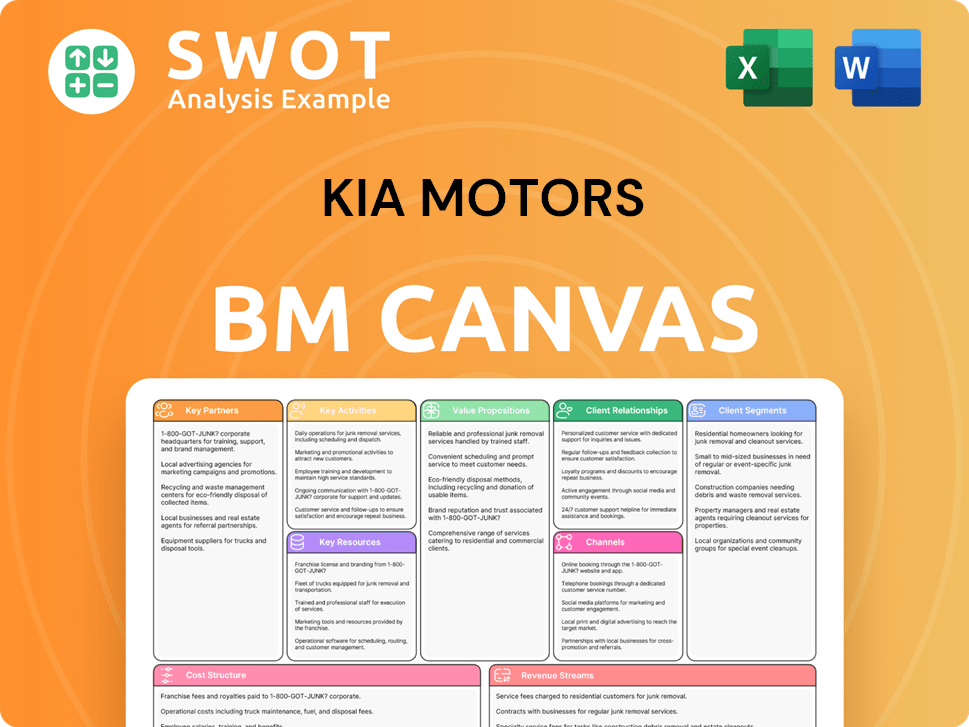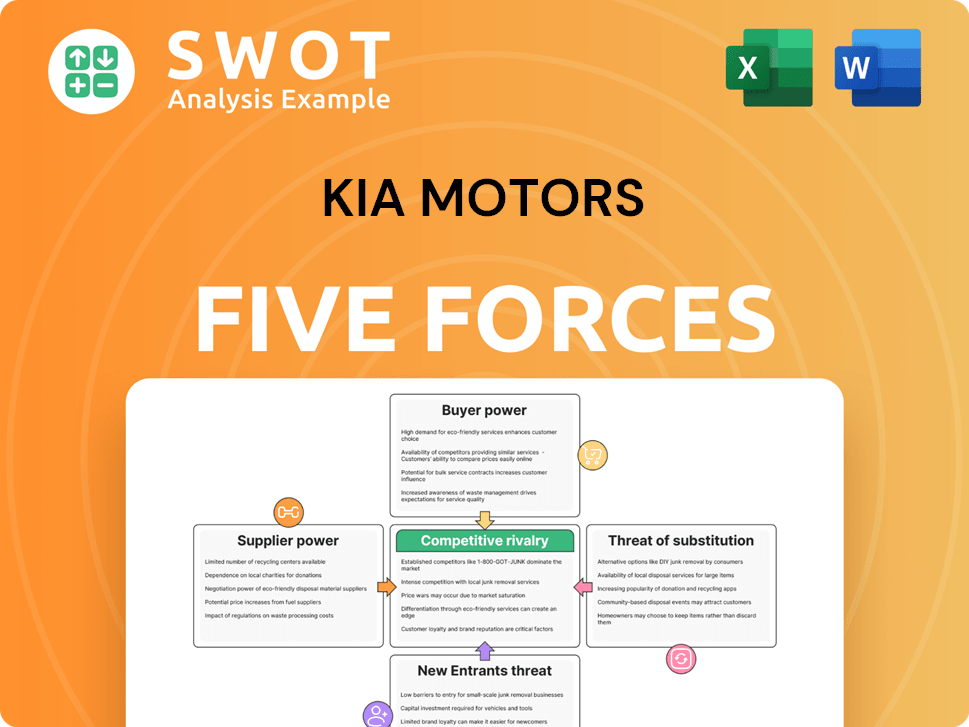Kia Motors Bundle
How Does Kia Motors Conquer the Global Automotive Market?
Kia Corporation, a South Korean automotive giant, has become a global powerhouse, celebrated for its innovation and striking designs. In 2024, Kia achieved record-breaking sales and surpassed KRW 100 trillion in revenue, signaling its strong market position. Understanding Kia Motors SWOT Analysis is crucial for anyone looking to understand the company's competitive advantages and future potential.

This analysis will explore the inner workings of Kia, from its manufacturing processes to its strategic initiatives. We will examine how Kia, a leading Kia brand, has built a global presence and continues to adapt to the evolving automotive landscape. Delving into its financial performance and future plans, we'll uncover the key factors driving Kia's success and how Kia vehicles are shaping the future of mobility. This will help you to understand How Kia Works.
What Are the Key Operations Driving Kia Motors’s Success?
The core operations of the Kia Company revolve around the design, manufacturing, and distribution of a diverse range of vehicles. This includes sedans, SUVs, and commercial vehicles, catering to a global customer base. The company's operational structure leverages advanced manufacturing techniques and a robust global network to ensure efficient production and delivery.
The value proposition of Kia centers on delivering vehicles that combine appealing design, advanced technology, and a superior driving experience. This is supported by strong warranties and a commitment to customer satisfaction, both online and in dealerships. Kia's strategic focus on sustainable mobility, with its investments in electric and hybrid vehicles, further enhances its appeal to environmentally conscious consumers.
In 2024, key models like the Sportage, Seltos, and Sorento SUVs were top sellers. The Sportage alone sold 587,717 units worldwide. Kia continues to expand its hybrid and electric vehicle offerings, including models like the EV6 and EV9, reflecting a commitment to sustainable mobility. The company's affiliation with the Hyundai Motor Group provides access to shared resources, particularly in research and development, accelerating technological advancements.
Kia's manufacturing processes use advanced automation and robotics to enhance precision and reduce costs. The global network ensures efficient supply and delivery. The company's manufacturing process is a key factor in its operational efficiency.
The Kia brand emphasizes design and technology to meet global consumer preferences. This includes superior driving experiences and appealing styling. The company continuously innovates to stay competitive in the automotive market.
Kia invests in market research to understand consumer desires. Competitive warranties and customer service enhance brand perception. This approach helps to build customer loyalty and improve the overall brand image.
Kia is focused on sustainable mobility by investing in green technology and expanding its electric and hybrid car lineup. This attracts environmentally conscious consumers. The expansion of the EV lineup is a key part of Kia's future plans.
The company's success is driven by its efficient manufacturing processes, global distribution network, and focus on customer satisfaction. Kia's ability to adapt to market trends and consumer demands is crucial for its continued growth. To understand the target market of Kia Motors, read the article Target Market of Kia Motors.
- Advanced Manufacturing: Utilizing automation and robotics for precision and cost reduction.
- Global Network: Efficient supply chain and worldwide vehicle distribution.
- Customer Focus: Emphasis on superior driving experience, appealing styling, and warranties.
- Sustainable Mobility: Investments in electric and hybrid vehicles.
Kia Motors SWOT Analysis
- Complete SWOT Breakdown
- Fully Customizable
- Editable in Excel & Word
- Professional Formatting
- Investor-Ready Format

How Does Kia Motors Make Money?
The primary revenue stream for Kia Motors comes from selling its diverse range of vehicles. This includes passenger cars, SUVs, and commercial vehicles, forming the core of its financial performance. The Kia brand has seen significant growth, particularly in recent years, driven by increasing sales and strategic product offerings.
In 2024, Kia Company achieved record revenues and profitability. This success reflects the company's effective strategies in both sales and financial management. The focus on high-margin models and favorable exchange rates contributed significantly to its robust financial results.
Kia's revenue streams are expanding beyond vehicle sales. The company is exploring new avenues such as platform fees, bundled services, and cross-selling opportunities, particularly within its Platform Beyond Vehicle (PBV) business. These strategies are designed to enhance customer engagement and drive additional revenue growth.
Kia's financial performance in 2024 was exceptionally strong. The company reported annual revenue of KRW 107.45 trillion (approximately $75 billion), a 7.7% increase from the previous year. Operating profit reached KRW 12.67 trillion, with an operating profit margin of 11.8%. This performance surpassed several global rivals.
- For 2025, Kia has set an ambitious revenue target of KRW 112.5 trillion, a 4.7% increase from 2024.
- The company anticipates maintaining an operating profit margin of 11%.
- The launch of new models, including the EV3, EV4, EV5, and the new K4 sedan, along with a hybrid model of the Carnival MPV, and the Tasman pickup, is expected to drive further revenue growth.
- The PBV business is projected to be a major growth driver, targeting 250,000 annual sales by 2030.
- Kia's focus on software-defined vehicles (SDVs) will introduce additional revenue opportunities through enhanced connectivity features and over-the-air updates.
- Aftermarket services, including high-quality parts and accessories, will also contribute to revenue and customer loyalty.
Kia Motors PESTLE Analysis
- Covers All 6 PESTLE Categories
- No Research Needed – Save Hours of Work
- Built by Experts, Trusted by Consultants
- Instant Download, Ready to Use
- 100% Editable, Fully Customizable

Which Strategic Decisions Have Shaped Kia Motors’s Business Model?
Kia Motors has achieved significant milestones, particularly in its shift towards electrification and sustainable mobility. In 2024, Kia set a new annual global sales record, selling 3.09 million units. The company also surpassed KRW 100 trillion in annual revenue for the first time, reaching KRW 107.45 trillion. This growth was supported by the launch of new models like the EV3, the K4 sedan, and a hybrid version of the Carnival MPV.
Strategic moves include a strong focus on the electric vehicle (EV) market. Kia aims to increase EV sales to 1.26 million units by 2030, supported by a range of new EV models. The company is also expanding local EV production in key regions, with Korea as its global hub for EV development. North America will focus on mid-to-large SUVs, Europe on compact SUVs, and India on locally targeted compact SUVs. Furthermore, Kia is entering the pickup truck segment with the Tasman (ICE) and an electric pickup, targeting 80,000 and 90,000 units annually, respectively. The development of Platform Beyond Vehicle (PBV) models, starting with the PV5 in 2025, represents a significant strategic move into a new business area.
Kia's competitive edge is multifaceted. Its robust brand reputation, valued at $6.7 billion and growing 6.7% annually, reflects consumer trust and market presence. The company emphasizes superior driving experiences, design, and performance. Innovation and research are central, with investments in R&D leading to advancements in automotive technology. Technologically advanced manufacturing, competitive warranties, and a focus on sustainability further differentiate Kia. Strategic partnerships are expanding EV charging infrastructure and accelerating technological advancement. Kia's agile response to market dynamics allows it to introduce new products and remain competitive. For more details on how Kia plans to expand, you can read about the Growth Strategy of Kia Motors.
Kia set a new global sales record in 2024, selling 3.09 million units. Kia surpassed KRW 100 trillion in annual revenue, reaching KRW 107.45 trillion. The launch of new models like the EV3 and K4 sedan supported this growth.
Kia aims to increase EV sales to 1.26 million units by 2030. The company is expanding local EV production in key regions. Kia is entering the pickup truck segment with the Tasman and an electric pickup.
Kia's brand is valued at $6.7 billion and growing 6.7% annually. The company focuses on superior driving experiences, design, and performance. Kia emphasizes innovation, R&D, and sustainability.
Kia plans to introduce a full volume model range including the EV2, EV3, EV4, EV5, and EV9. The development of Platform Beyond Vehicle (PBV) models, starting with the PV5 in 2025, represents a significant strategic move.
Kia is focusing on several key areas to maintain its competitive edge and drive future growth.
- Electrification: Expanding its EV lineup and increasing EV sales targets.
- Global Production: Localizing EV production in key markets to meet demand.
- Innovation: Investing in R&D to advance automotive technology.
- Strategic Partnerships: Collaborating to expand EV charging infrastructure.
Kia Motors Business Model Canvas
- Complete 9-Block Business Model Canvas
- Effortlessly Communicate Your Business Strategy
- Investor-Ready BMC Format
- 100% Editable and Customizable
- Clear and Structured Layout

How Is Kia Motors Positioning Itself for Continued Success?
The Growth Strategy of Kia Motors is built on a strong foundation within the global automotive industry. In 2024, the company achieved record-high global sales of 3.09 million units and an impressive operating profit margin of 11.8%. This performance outshone several major competitors, demonstrating its robust market position. Kia's brand value is also significant, currently at $6.7 billion and growing.
Despite its strengths, Kia faces several challenges. Increased competition, particularly from Chinese automakers and tech companies entering the EV and autonomous driving sectors, poses a significant threat. Financial risks arise from rising raw material costs and currency fluctuations. Adapting to rapidly changing consumer preferences, especially the shift towards electric vehicles, and evolving regulatory requirements, are ongoing challenges that demand continuous innovation.
Kia has a strong global presence, selling vehicles in over 190 countries. It is the second-largest automaker in South Korea. Customer loyalty is fostered through excellent customer experience and competitive vehicle warranties. The company's focus on customer satisfaction has helped it maintain a competitive edge.
Kia faces intense competition from both established automakers and new entrants, particularly in the EV market. Rising raw material costs and currency fluctuations impact profitability. Adapting to the rapid changes in consumer preferences and regulatory requirements is crucial.
Kia plans to increase global sales to 3.22 million units in 2025, a 4.1% increase from 2024. The company aims for KRW 112.5 trillion in revenue and an operating profit margin of 11%. By 2030, Kia targets global sales of 4.19 million units, with 2.33 million being electrified vehicles.
Kia will launch five new models in 2025, including new EVs such as the EV3, EV4, and EV5. It will expand its Platform Beyond Vehicle (PBV) lineup with the PV5, PV7, and PV9. A significant investment of KRW 42 trillion is planned over the next five years, with KRW 19 trillion allocated to future businesses.
Kia's strategic focus includes solidifying its leadership in the EV market and maintaining sales momentum through an expanded EV lineup. The company is also prioritizing the successful launch of its PBV business and focusing on cost competitiveness and enhanced customer service.
- Launch of new EV models and expansion of PBV lineup.
- Significant investments in electrification, software-defined vehicles (SDVs), robotics, and Advanced Air Mobility (AAM).
- Focus on cost competitiveness and improving customer service to enhance brand loyalty.
- Targeting global sales of 3.22 million units in 2025.
Kia Motors Porter's Five Forces Analysis
- Covers All 5 Competitive Forces in Detail
- Structured for Consultants, Students, and Founders
- 100% Editable in Microsoft Word & Excel
- Instant Digital Download – Use Immediately
- Compatible with Mac & PC – Fully Unlocked

Related Blogs
- What are Mission Vision & Core Values of Kia Motors Company?
- What is Competitive Landscape of Kia Motors Company?
- What is Growth Strategy and Future Prospects of Kia Motors Company?
- What is Sales and Marketing Strategy of Kia Motors Company?
- What is Brief History of Kia Motors Company?
- Who Owns Kia Motors Company?
- What is Customer Demographics and Target Market of Kia Motors Company?
Disclaimer
All information, articles, and product details provided on this website are for general informational and educational purposes only. We do not claim any ownership over, nor do we intend to infringe upon, any trademarks, copyrights, logos, brand names, or other intellectual property mentioned or depicted on this site. Such intellectual property remains the property of its respective owners, and any references here are made solely for identification or informational purposes, without implying any affiliation, endorsement, or partnership.
We make no representations or warranties, express or implied, regarding the accuracy, completeness, or suitability of any content or products presented. Nothing on this website should be construed as legal, tax, investment, financial, medical, or other professional advice. In addition, no part of this site—including articles or product references—constitutes a solicitation, recommendation, endorsement, advertisement, or offer to buy or sell any securities, franchises, or other financial instruments, particularly in jurisdictions where such activity would be unlawful.
All content is of a general nature and may not address the specific circumstances of any individual or entity. It is not a substitute for professional advice or services. Any actions you take based on the information provided here are strictly at your own risk. You accept full responsibility for any decisions or outcomes arising from your use of this website and agree to release us from any liability in connection with your use of, or reliance upon, the content or products found herein.